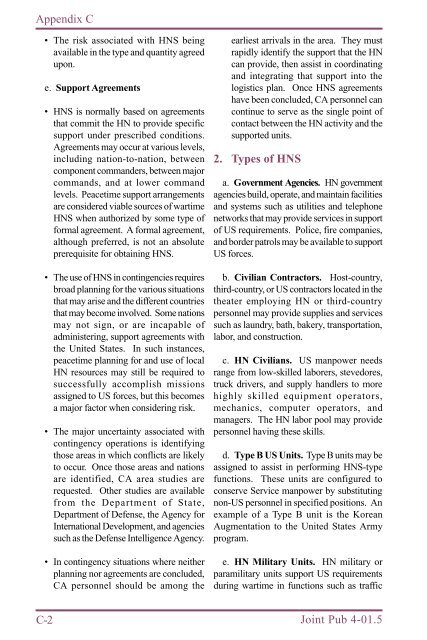JP 4-01.5 JTTP for Water Terminal Operations - BITS
JP 4-01.5 JTTP for Water Terminal Operations - BITS
JP 4-01.5 JTTP for Water Terminal Operations - BITS
Create successful ePaper yourself
Turn your PDF publications into a flip-book with our unique Google optimized e-Paper software.
Appendix C<br />
C-2<br />
• The risk associated with HNS being<br />
available in the type and quantity agreed<br />
upon.<br />
e. Support Agreements<br />
• HNS is normally based on agreements<br />
that commit the HN to provide specific<br />
support under prescribed conditions.<br />
Agreements may occur at various levels,<br />
including nation-to-nation, between<br />
component commanders, between major<br />
commands, and at lower command<br />
levels. Peacetime support arrangements<br />
are considered viable sources of wartime<br />
HNS when authorized by some type of<br />
<strong>for</strong>mal agreement. A <strong>for</strong>mal agreement,<br />
although preferred, is not an absolute<br />
prerequisite <strong>for</strong> obtaining HNS.<br />
• The use of HNS in contingencies requires<br />
broad planning <strong>for</strong> the various situations<br />
that may arise and the different countries<br />
that may become involved. Some nations<br />
may not sign, or are incapable of<br />
administering, support agreements with<br />
the United States. In such instances,<br />
peacetime planning <strong>for</strong> and use of local<br />
HN resources may still be required to<br />
successfully accomplish missions<br />
assigned to US <strong>for</strong>ces, but this becomes<br />
a major factor when considering risk.<br />
• The major uncertainty associated with<br />
contingency operations is identifying<br />
those areas in which conflicts are likely<br />
to occur. Once those areas and nations<br />
are identified, CA area studies are<br />
requested. Other studies are available<br />
from the Department of State,<br />
Department of Defense, the Agency <strong>for</strong><br />
International Development, and agencies<br />
such as the Defense Intelligence Agency.<br />
• In contingency situations where neither<br />
planning nor agreements are concluded,<br />
CA personnel should be among the<br />
earliest arrivals in the area. They must<br />
rapidly identify the support that the HN<br />
can provide, then assist in coordinating<br />
and integrating that support into the<br />
logistics plan. Once HNS agreements<br />
have been concluded, CA personnel can<br />
continue to serve as the single point of<br />
contact between the HN activity and the<br />
supported units.<br />
2. Types of HNS<br />
a. Government Agencies. HN government<br />
agencies build, operate, and maintain facilities<br />
and systems such as utilities and telephone<br />
networks that may provide services in support<br />
of US requirements. Police, fire companies,<br />
and border patrols may be available to support<br />
US <strong>for</strong>ces.<br />
b. Civilian Contractors. Host-country,<br />
third-country, or US contractors located in the<br />
theater employing HN or third-country<br />
personnel may provide supplies and services<br />
such as laundry, bath, bakery, transportation,<br />
labor, and construction.<br />
c. HN Civilians. US manpower needs<br />
range from low-skilled laborers, stevedores,<br />
truck drivers, and supply handlers to more<br />
highly skilled equipment operators,<br />
mechanics, computer operators, and<br />
managers. The HN labor pool may provide<br />
personnel having these skills.<br />
d. Type B US Units. Type B units may be<br />
assigned to assist in per<strong>for</strong>ming HNS-type<br />
functions. These units are configured to<br />
conserve Service manpower by substituting<br />
non-US personnel in specified positions. An<br />
example of a Type B unit is the Korean<br />
Augmentation to the United States Army<br />
program.<br />
e. HN Military Units. HN military or<br />
paramilitary units support US requirements<br />
during wartime in functions such as traffic<br />
Joint Pub 4-<strong>01.5</strong>
















